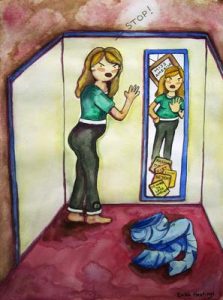Bulimia Vs. Anorexia
 Of all the eating disorders that exist, none are more known than anorexia nervosa and bulimia nervosa. But what is the difference between these two eating disorders? How are they alike and how are they different? How can you identify bulimia vs. anorexia?
Of all the eating disorders that exist, none are more known than anorexia nervosa and bulimia nervosa. But what is the difference between these two eating disorders? How are they alike and how are they different? How can you identify bulimia vs. anorexia?
Eating Disorders are diagnosed using the criteria put forth in the Diagnostic and Statistical Manual of Mental Disorders, 4th Edition (DSM-IV). The criteria for both anorexia and bulimia can be found in this book and they are quite distinct. Though both disorders can present with a variety of clinical pictures, in general anorexics refrain from eating while bulimics binge and purge.
There Are Some Similarities between Bulimia and Anorexia
People with both anorexia and bulimia have a dysfunctional relationship with food. Both types of disorders cause feelings of shame and disgust with the self. Both can cause serious and permanent damage to the body, up to, and including death. In both anorexia and bulimia malnutrition may occur, as well as osteoporosis, or a softening of the bones due to a lack of sufficient vitamins and minerals in the diet. In addition, with both anorexia and bulimia people are obsessed with their body weight, have a distorted body image, and usually experience low-self esteem. In addition, both types of eating disorders are treatable and recovery is possible from both disorders.
Anorexics Refuse to Eat
However, the disorders are also very different from one another. For instance, anorexia symptoms generally include a refusal to eat or to maintain a normal body weight. People with anorexia are usually underweight or emaciated and, if female, they will have stopped menstruating. In advanced cases of anorexia, people will be intolerant to cold and may develop a layer of fine hair called lanugo. They can experience cardiovascular failure, and damage to the major organ systems.
Bulimics Binge and Purge
In contrast, symptoms of bulimia include a body that appears normal weight to slightly overweight. Because of the methods of purging bulimics use such as laxatives, diuretics, and inducing vomiting, extreme electrolyte imbalances can occur. Erosion of the teeth and damage to the gums may occur as a result of frequent contact with stomach acid. Bulimics secretly binge on enormous amounts of food and then also conceal their purging behavior.
 Eating Disorder Self Test. Take the EAT-26 self test to see if you might have eating disorder symptoms that might require professional evaluation. All answers are confidential.
Eating Disorder Self Test. Take the EAT-26 self test to see if you might have eating disorder symptoms that might require professional evaluation. All answers are confidential.